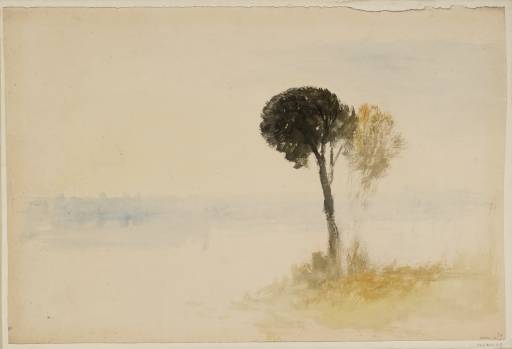Joseph Mallord William Turner ?Buckingham Palace c.1828
Joseph Mallord William Turner,
?Buckingham Palace
c.1828
Joseph Mallord William Turner 1775–1851
?Buckingham Palace c.1828
D25151
Turner Bequest CCLXIII 29
Turner Bequest CCLXIII 29
Watercolour on white wove paper, 346 x 511 mm
Inscribed in red ink ‘29’ bottom right
Blind-stamped with Turner Bequest monogram towards bottom centre
Stamped in black ‘CCLXIII – 29’ bottom right
Inscribed in red ink ‘29’ bottom right
Blind-stamped with Turner Bequest monogram towards bottom centre
Stamped in black ‘CCLXIII – 29’ bottom right
Accepted by the nation as part of the Turner Bequest 1856
Exhibition history
1937
Four Screens, British Museum, London, February 1937–February 1938 (no catalogue but frame number 10, as ‘Trees by a River’).
1974
Turner 1775–1851, Royal Academy, London, November 1974–March 1975 (467, reproduced, as ‘Two Trees in a Landscape’).
1976
J.M.W. Turner 1775–1851: Akvareller og Tegninger fra British Museum, Statens Museum for Kunst, Copenhagen, February–May 1976 (73, reproduced, as ‘Two Trees in a Landscape’).
1976
William Turner und die Landschaft seiner Zeit, Hamburger Kunsthalle, May–July 1976 (96, reproduced as ‘Zwei Bäume in einer Landschaft’).
1978
Watercolours from the Turner Bequest, Lent by the British Museum, Tate Gallery, London, January–June 1978 (no catalogue, as ‘Two Trees in a Landscape’).
2001
William Turner: Licht und Farbe, Museum Folkwang, Essen, September 2001–January 2002, Kunsthaus Zürich, February–May (151, reproduced in colour, as ‘Two Trees in a Landscape’, c.1828).
2007
J.M.W. Turner (1775–1851); F.A. Ravier (1814–1895): Lumières partagées: Aquarelles, Maison Ravier, Morestel, June–September 2007 (no number, reproduced in colour, as ‘An Italian Landscape’, c.1820–30).
References
1909
A.J. Finberg, A Complete Inventory of the Drawings of the Turner Bequest, London 1909, vol.II, p.816, CCLXIII 29, as ‘An Italian landscape’. c.1820–30.
1975
George Steiner, ‘At the Turner Exhibition’, Encounter, vol.44, no.4, April 1975, p.60.
1997
Eric Shanes, Turner’s Watercolour Explorations 1810–1842, exhibition catalogue, Tate Gallery, London 1997, pp.19, 95 Appendix I under ‘Domed Mansion, possibly Buckingham Palace’, 95 under ‘England and Wales Series’, as ‘Sketch for a view of Buckingham Palace’. ?c.1828, p.104 Appendix II, as ‘Sketch: ?Buckingham Palace’.
Eric Shanes has suggested that this colour study, along with Tate D25283, D25284 and D25310 (Turner Bequest CCLXIII 161, 162, 188), is for an undeveloped view of Buckingham Palace in central London for Turner’s Picturesque Views in England and Wales.1 As he notes, the building ‘sported a dome for a short time in the 1820s’,2 when the former Buckingham House was redeveloped in palatial, classical style by John Nash (1752–1832) for King George IV (1820–1830).3 There are engravings made around 1830 showing the palace in this intermediate state: The Garden Front of the King’s Palace in Pimlico from the west, across the lake in its gardens, by Thomas Higham (1796–1844), and The King’s Palace, Pimlico from the east, across the lake in St James’s Park, after Thomas Hosmer Shepherd (1793–1864) (both London Metropolitan Archives). The engraving from the west in particular shows the central dome and four flanking rectangular attic pavilions; the latter were presumably demolished when the dome was replaced by the present central rectangular attic floor before 1847.4
Turner had recorded the west side of Buckingham House and its gardens before its aggrandisement in a panoramic drawing made in the late 1810s from the adjacent London home of his Yorkshire patron and friend and Walter Fawkes, in the Skies sketchbook (Tate D12523, Tate D12524; Turner Bequest CLVIII 67a–68), the basis of the watercolour London, from the Windows of 45 Grosvenor Place of about 1819 (private collection),5 but there are no identified sketches of the palace as such.
The three other colour studies mentioned at the beginning of this entry focus on the silhouette of a building with a central dome and flanking rectangular projections on the skyline, which correlate fairly well with Nash’s design, though it has previously been suggested that they may represent Hampton Court Palace from the Thames. Here the building is less prominent in the distance on the left, although its profile and its reflection do seem to indicate a central dome with rooftop projections either side. It has been catalogued and exhibited with generic titles such as ‘An Italian Landscape’ and ‘Two Trees in a Landscape’, and shows a general debt the serene, light-filled classical landscapes of Claude Lorrain (1604/5–1682) so admired and so often emulated by Turner.6 The broad expanse of water in this case may be a river or natural lake, and the Buckingham Palace identification is likely to remain speculative.
The critic and philosopher George Steiner has mentioned this work as one with ‘a lightness, a delicacy of touch, which make Turner a rival to the Chinese artificers of the 14th century.’7
See also the introductions to the present subsection of identified but unrealised subjects and the overall England and Wales ‘colour beginnings’ grouping to which this work has been assigned.
See ‘History [of Buckingham Palace]’, The British Monarchy, accessed 19 March 2013, http://www.royal.gov.uk/TheRoyalResidences/BuckinghamPalace/History.aspx .
Verso:
Blank
Blank
Matthew Imms
March 2013
How to cite
Matthew Imms, ‘?Buckingham Palace c.1828 by Joseph Mallord William Turner’, catalogue entry, March 2013, in David Blayney Brown (ed.), J.M.W. Turner: Sketchbooks, Drawings and Watercolours, Tate Research Publication, December 2013, https://www

